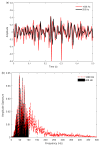Feature Extraction and Selection for Myoelectric Control Based on Wearable EMG Sensors
- PMID: 29783659
- PMCID: PMC5982518
- DOI: 10.3390/s18051615
Feature Extraction and Selection for Myoelectric Control Based on Wearable EMG Sensors
Abstract
Specialized myoelectric sensors have been used in prosthetics for decades, but, with recent advancements in wearable sensors, wireless communication and embedded technologies, wearable electromyographic (EMG) armbands are now commercially available for the general public. Due to physical, processing, and cost constraints, however, these armbands typically sample EMG signals at a lower frequency (e.g., 200 Hz for the Myo armband) than their clinical counterparts. It remains unclear whether existing EMG feature extraction methods, which largely evolved based on EMG signals sampled at 1000 Hz or above, are still effective for use with these emerging lower-bandwidth systems. In this study, the effects of sampling rate (low: 200 Hz vs. high: 1000 Hz) on the classification of hand and finger movements were evaluated for twenty-six different individual features and eight sets of multiple features using a variety of datasets comprised of both able-bodied and amputee subjects. The results show that, on average, classification accuracies drop significantly ( p.
Keywords: EMG; L-moments; electromyography; feature extraction; pattern recognition; prosthesis; sampling rate; wearable sensor.
Conflict of interest statement
The authors declare no conflict of interest. The founding sponsors had no role in the design of the study; in the collection, analyses, or interpretation of data; in the writing of the manuscript, and in the decision to publish the results.
Figures






References
-
- Phinyomark A., Phukpattaranont P., Limsakul C. A review of control methods for electric power wheelchairs based on electromyography signals with special emphasis on pattern recognition. IETE Tech. Rev. 2011;28:316–326. doi: 10.4103/0256-4602.83552. - DOI
-
- Oskoei M.A., Hu H. Myoelectric control systems—A survey. Biomed. Signal Process. Control. 2007;2:275–294. doi: 10.1016/j.bspc.2007.07.009. - DOI
-
- Saponas T.S., Tan D.S., Morris D., Balakrishnan R., Turner J., Landay J.A. Enabling always-available input with muscle-computer interfaces; Proceedings of the 22nd Annual ACM Symposium on User Interface Software and Technology; Victoria, BC, Canada. 4–7 October 2009; New York, NY, USA: ACM; 2009. pp. 167–176.
-
- Phinyomark A., Quaine F., Laurillau Y. The Relationship between Anthropometric Variables and Features of Electromyography Signal for Human—Computer Interface. In: Naik G.R., editor. Applications, Challenges, and Advancements in Electromyography Signal Processing. IGI Global; Hershey, PA, USA: 2014. pp. 321–353. Chapter 15.
-
- Tabor A., Bateman S., Scheme E. Game-Based Myoelectric Training; Proceedings of the ACM SIGCHI Annual Symposium on Computer-Human Interaction in Play Companion; Austin, TX, USA. 16–19 October 2016; New York, NY, USA: ACM; 2016. pp. 299–306.
MeSH terms
LinkOut - more resources
Full Text Sources
Other Literature Sources

